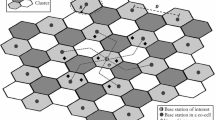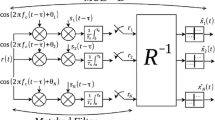Abstract
Capacity and power control issues are considered for urban CDMA microcells that operate on channels characterized by log-normal shadowing and Nakagami fading. The effects of fading on the desired and interfering signals, variations in the shadow standard deviation, imperfect power control, and the requiredE b /N o for satisfactory link operation are investigated. It is shown that the reverse channel is relatively insensitive, and the forward channel very sensitive, to shadow and fading variations. Power control error is shown to significantly degrade reverse channel capacity. Twobiased forward channel power control strategies are introduced to enhance existing unbiasedbalancing forward channel power control algorithms.
Similar content being viewed by others
References
K.S. Gilhousen, I.M. Jacobs, R. Padovani, L.A. Weaver, Jr. and C.W. III, On the capacity of a cellular CDMA system. IEEE Trans. Veh. Tech. VT-40 (1991) 303–312.
E. Kudoh and T. Matsumoto, Effects of power control error on the system user capacity of DS/CDMA cellular mobile radios, IEICE Trans. E75-B (1992) 524–529.
P. Newson and M.R. Heath, The capacity of a spread spectrum CDMA system for cellular mobile radio with consideration of system imperfections, IEEE J. Select. Areas Commun. (1994) 673–683.
M.A. Mokhtar and S.C. Gupta, Capacity for cellular CDMA PCS's in Nakagami fading log-normal shadowing channels,IEEE ICUPC (1992) pp. 190–194.
S. Ariyavisitakul and L.F. Chang, Signal and interference statistics of a CMDA system with feedback power control, IEEE Trans. Commun. COM-41 (1993) 1626–1634.
C.J. Chang and F.C. Ren, Downlink power control in DS/CDMA cellular mobile radio networks,IEEE ICUPC (1994) pp. 89–93.
M. Zorzi, Simplified forward-link power control law in cellular CDMA, IEEE Trans. Veh. Tech. (November 1994) 1088–1093.
EIA/TIA, Mobile station-base station compatability standard for dual-mode wideband spread Spectrum cellular System, Tech. Rep. IS-95, EIA/TIA (1992).
S. Kozono and A. Taguchi, Mobile propagation loss and delay spread characteristics with a low base station antenna on an urban road, IEEE Trans. Veh. Tech. VT-42 (1993) 103–108.
M. Nakagam, Them distribution; a general formula of intensity distribution of rapid fading, in:Statistical Methods in Radio Wave Propagation, ed. W.G. Hoffman (Oxford Univ. Press, England, 1960).
J.-E. Berg, R. Bownds and F. Lotse, Path loss and fading models for microcells at 900 MHz,IEEE Veh. Technol. Conf. (1992) pp. 666–671.
M.-J. Ho and G.L. Stüber, Co-channel interference of microcellular systems on shadowed Nakagami fading channels,IEEE Veh. Technol. Conf. (1993) pp. 568–571.
I. Gradshteyn and I. Ryzhik,Tables of Integrals, Series, and Products (Academic Press, 1980).
Author information
Authors and Affiliations
Additional information
This research has been supported by BNR Inc.
Rights and permissions
About this article
Cite this article
Ho, MJ., Stüber, G.L. Capacity and power control for CDMA microcells. Wireless Netw 1, 355–363 (1995). https://doi.org/10.1007/BF01200852
Issue Date:
DOI: https://doi.org/10.1007/BF01200852




